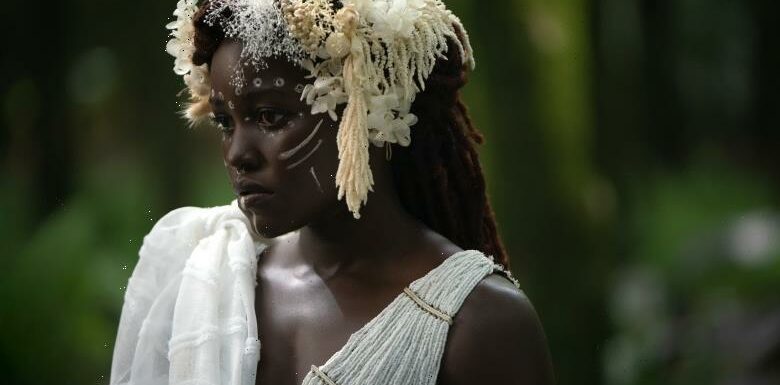
“It’s not another superhero movie,” Camille Friend, the hair department lead on both “Black Panther” and “Black Panther: Wakanda Forever,” says of Ryan Coogler’s Marvel sequel. “It’s a movie with heart, with soul, and we care about what is happening on the screen and behind the screen, and we have people of color [on both sides]. And we can do excellence in a movie — we do that.”
An Oscar nominee for her work “Wakanda Forever,” Friend estimates that probably 95 percent of the “Black Panther” crew returned for the sequel’s shoot in Atlanta in summer of 2021. And it was a tough return for everyone after Black Panther himself, Chadwick Boseman, died of cancer less than a year earlier.
“Everybody was pretty broken still and were grieving,” says Friend. “One of the most beautiful things is that [director] Ryan [Coogler] had us all get on a plane and go to Chadwick’s grave to have a little service. We had drummers there. And his best friend, Jabari. It was momentous, and we needed it because it gave us more closure. When we got back to Atlanta, it was like, OK, get down to work.”
The opening scenes of “Wakanda Forever” mirror the grief and the closure happening off-camera with a glorious send-off for King T’Challa featuring 200 extras all in white, representing all the tribes.
“I wanted everybody to be able to tell which tribe was which,” says Friend. “So I tried to integrate the hair looks within that whole mourning scene. And Ruthie [costume designer Ruth Carter] did an excellent job of putting everyone in white but showing the individualism in each tribe’s outfits, too.”
“Black Panther: Wakanda Forever”
Courtesy of Marvel Studios
The Mining Tribe is inspired by the Himba people of northern Namibia, whose women are known for applying a paste of butter, fat and red ochre to their hair and skin. “We built our own clay wigs because you can’t call 1-800-Africa, and someone will just send those wigs to you,” Friend says. “I have a really talented crew, and they were great at perfecting those wigs. Actually, they’re what we called our ‘Home Depot wigs’ because they are made out of plaster of paris and real paint.”
Senegalese warriors inspired the Jabari Tribe’s haircuts, giving Friend and her team a reference for the lines, shapes and warrior paint.
The River Tribe of Nikia (Lupita Nyong’o) made its onscreen debut in the sequel. “Here you see people with the lip plates, flowers in their hair,” Friend explained. “And then last is The Border Tribe. Because they’re Wakanda’s army, we always wanted to make them look like military guys. So, everybody has a high-and-tight.”
For Ramonda (Oscar nominee Angela Bassett) and Shuri (Letitia Wright), the concept was taken from a grieving ritual of shaved heads in African culture. “They would have been grieving for a year after T’Challa died, so what would their hair look like after that year of mourning?”
For [Ramonda], Friend kept the Queen’s hair the same platinum and silver tones, so it was familiar, but with her locs now gone wanted to keep it looking beautiful, stately. She worked in tandem with Carter and the many hats costume put Ramonda in.
“Her hair should look like a crown,” says Friend. “So that’s where we came in with the curls and the shape so that no matter if she has on a hat or not, she was still our queen.”
With Shuri, Friend wanted to show that she’d evolved from this funny kid into a young woman: “I kept her side shaved but made her top curly. We took the braids out and made her look like a young woman mourning and trying to figure herself out, having to step up and be a leader, be the princess.”
The biggest change (and challenge) for Friend was the addition of the Talokan storyline. The sea people are inspired by ancient Mayans, and like everything in Coogler’s universe, authenticity and traditional accuracy were important. But when Friend started researching, she realized that because the Mayan culture had been dead for so long, there wasn’t a lot for her to find on the internet easily.
Read More: Why Murkiness Mattered for Wētā FX’s ‘Wakanda Forever’ Water
“Really awesomely, Marvel hired us Professor Geraldo Aldana, an expert in Mayan studies,” she says. “He was our go-to for what [anything] looked like. He explained to me which hairstyles would be more for a woman who was married or single and which would be for an older woman. He gave us such wisdom and guided us through that process.”
“Black Panther: Wakanda Forever”
Annette Brown
Once Friend began designing the Talokanil’s hairstyles, she would send them to Aldana, and if it wasn’t fully culturally appropriate, then she’d scrap the idea. On their big underwater shoot days, Friend had anywhere from 25 to 40 Talokanil, each with individual hair pieces and styles.
“We found out in camera tests that the product we’d put on these wigs produced a big white cloud when they got in the water,” says Friend. “I was like, oh boy, that doesn’t look good. And the hair had to look good underwater, but we couldn’t use any gels or hairsprays. We came up with what I call a glue hairspray—we took hair glue and thinned it out with alcohol in order to be able to spray it through a bottle and onto the hair. We did a couple tests, and it didn’t turn the water white, and the hair stayed in their styles underwater. It also held up under the pressure of the water and for the long hours in the water. It was something we needed to figure out, and we just did.”
Source: Read Full Article


